Blower Recommendation for Wolf Pro Island Hood
If anyone has experience selecting a blower for a Wolf Pro Island hood I would like to hear about your experiences. I'm looking at two options: the internal 1200 cfm blower or the inline 1100 cfm blower, which would be mounted in the attic, probably along with a Fantech silencer. The duct run will be about 12 feet straight up through the ceiling, 2nd story, attic and roof. In theory the attic mount will be more quiet, but it's also substantially more expensive.
As to the choice of the hood, I narrowed down our island hood selection to the 42" Wolf Pro island or the Independent Santa Fe Island. Independent was very helpful on the phone and I'm sure their products are top-notch (I believe they still make some of Wolf's hoods). However, in the end I chose the Wolf Pro Island for the following reasons:
- Ease of mounting. The Wolf uses an optional stainless duct cover that actually serves as the structural mount for the hood. The duct cover attaches to the ceiling joists with 3" lag screws plus additional screw supports and the hood then attaches to the cover via 5/16" bolts. The Independent hangs from the ceiling via threaded rods and the duct cover is purely cosmetic. It looked like a lot more hassle to install.
- Finish. Since we will be installing the Wolf double ovens in classic stainless and also the sealed burner rangetop, also in classic, we felt it would be nice if the hood would match also.
- Speed control. Continuously variable on the Wolf, 3-speed on the Independent. This wasn't a big deal, but thought it was a nice feature.
- Availability. At least 6 weeks to order an Independent; the Wolf is on it's way and will be here by the 27th. The duct cover and blowers are in stock locally.
- Warranty. 1 yr for Indpendent, 5 yr for Wolf.
Pricing on the hood shells was nearly the same, but the Wolf duct cover is an extra $400+ and the blower an extra $200+ for the internal model. I haven't priced the inline yet but know it will be more.
Thanks for any recommendations on blower configuration.
Comments (23)
breezy_2
16 years agolast modified: 9 years agoGood choice on hoods. The pro wall hood is very nice, we have the 36 inch pro wall hood w/heat lamps and 900 cfm internal blower and love it! My only complaint is noise...not bad but hard to talk over.
I HIGHLY recommend anything other than an internal blower. We just built a new house and put in a 60 inch liner with a 2500 cfm roof mounted remote blower (not Wolf). On LOW, the 900 cfm internal blower is much louder than the 2500 cfm remote blower at its HIGHEST level.
Tom Pultz
Original Author16 years agolast modified: 9 years agoOK, I priced out the options for Wolf blowers. The 1100 cfm inline model is $29.00 more than the 1200 cfm internal and the 1200 cfm remote external is $10.00 less. They also make a 1500 cfm remote but I did not price that model since the recommended cfm rating for our rangetop is 900.
Based on these prices I am now seriously thinking of getting the remote rooftop blower. Since I'll be running new ducting up through the roof anyway it's probably less work to install a combination blower/vent than an inline unit + roof vent.
Also, going with the rooftop remote, which will be totally hidden on the rear slope of the roof, will provide enough room in the attic to install the Fantech silencer.
Would love to hear from others that have installed remote blowers.
Ciao.
Related Professionals
Amherst Kitchen & Bathroom Designers · Bethpage Kitchen & Bathroom Designers · Fox Lake Kitchen & Bathroom Designers · Wentzville Kitchen & Bathroom Designers · South Sioux City Kitchen & Bathroom Designers · Feasterville Trevose Kitchen & Bathroom Remodelers · Elk Grove Kitchen & Bathroom Remodelers · Hoffman Estates Kitchen & Bathroom Remodelers · Idaho Falls Kitchen & Bathroom Remodelers · Los Alamitos Kitchen & Bathroom Remodelers · San Juan Capistrano Kitchen & Bathroom Remodelers · Eureka Cabinets & Cabinetry · Rowland Heights Cabinets & Cabinetry · Whitney Cabinets & Cabinetry · Tabernacle Cabinets & Cabinetrykaseki
16 years agolast modified: 9 years agoI am in the process of determining the appropriate exhaust system for a Pro Island Hood (or a similar hood). Between residential recommendations from manufacturers and the developing theory for commercial applications (perhaps maturing is a better word), the answer is not obvious, assuming that massive overkill is not desirable to minimize required (desirable) make-up air.
The actual flow and the fan rating are greatly different. Fans are rated at zero static pressure; that is, mounted to a wall or roof with both sides at the same pressure. If you are lucky, you can find how the fans are rated versus pressure loss through the system. (See the Broan fan data sheets for example.) Pressure loss is due to pulling a slight house vacuum, flow through the hood baffles, past transitions, through ducts, etc. In one case I looked at, a 1500 cfm roof fan could apparently pull around 900 cfm.
Also, there is the question of what flow rate is actually needed, based on heat input, source diameter, upwelling volume, velocity, height to hood from cooking surface, hood overhang, etc. The answer for an induction hub will be different than for a gas burner.
I hope to provide some specific example when I have come to a conclusion for my conditions.
kas
Tom Pultz
Original Author16 years agolast modified: 9 years agoKas makes a lot of valid points, especially concerning the ratings of blowers, which are done with zero back pressure. Don't expect to buy a 600, 900 or whatever cfm blower and expect it to flow that much under real working conditions.
I'm actually now thinking of going with the 1500 cfm remote unit just because it has a lot more flow capability at higher operating static pressures compared to the 1200 cfm unit. [Aside: it appears the remote blowers sold by Wolf and by Best by Broan are from the same manufacturer since the dimensional specs on the Best by Broan website are exactly the same as on the Wolf website. Pricing also appears to be nearly identical. Since Wolf has a 5 yr warranty it's a no-brainer to go with Wolf for my hood].
Also, since the Wolf Pro Island hood has an infinite speed controller we would only use as much flow as necessary. Since the 1500 cfm has more flow capacity this would imply that it would run at a lower rpm than the 1200 cfm unit at the same flowrate, and thus be quieter (in theory).
Fantech provides an estimate of needed flow capacity that is far less than manufacturers like Wolf recommend. Fantech says to use 150 cfm per running length of cooking surface for gas appliances. So, our 3 ft rangetop would only need 450 cfm according to them... and 900 cfm according to Wolf.
Since we are installing an island hood, I think more flow capacity is better than less.
Looking forward to what Kas comes up with.
Tom
kaseki
16 years agolast modified: 9 years agoYes, island hoods don't have the advantage of a wall to direct one side of the effluent into the hood. The 2003 ASHRAE Handbook lists (for commercial hoods) a significant increase in flow for island hoods over wall hoods, even though commercial wall hoods are already 4 to 5 feet deep. (I don't have the book handy right now to quote numbers, but I think for island hoods the requirement was 300 to 400 cfm per foot of length, keeping in mind that commercial hoods are located at 6'6" or higher, and have to achieve sufficient air speed through the grease baffles.)
The Greenheck method (perhaps more relevant to California code inspectors) uses a hood area rule set for establishing cfm, and then throws in factors for certain conditions. I vaguely recall the island to wall factor for their approach being 1.2x.
Anyway, for residential applications that don't include a 30 x 30 inch gas-fired griddle, the difference may be that Wolf is expecting a serious gas range top under their hood, while Fantech might be considering a "normal" gas range. The actual effluent cfm that must be captured depends on the amount of heat put into the plumes by the burners, which excludes heat radiated or used to heat the food.
There are some excellent papers on this from a Finnish Institute. I'll hunt up the papers' names when I next get a chance so they can be searched by interested persons.
kas
Tom Pultz
Original Author16 years agolast modified: 9 years agoOur island configuration will have a 6" high wall behind the 84K BTU/hr rangetop via cabinets installed in the dining room. That's not much of a wall, but it should help direct fumes, etc. up into the hood instead of letting them migrate directly into the dining room. We have a totally open floor plan... no walls between the kitchen and dining room or kitchen and family room.
One good feature about the Wolf Pro Island hood is the 34" depth, which means it will overhang the burners on all sides. The pentroof internal design should also help direct the airflow upwards.
I think I need to start thinking about a makeup air solution other than opening a window.
kaseki
16 years agolast modified: 9 years agoReference articles:
Thermal plumes of kitchen appliances: part 1 idle mode
Thermal plumes of kitchen appliances: part 2 cooking
Tom Pultz
Original Author16 years agolast modified: 9 years agoI Googled the papers referenced by Kas. Not much of use to any normal homeowner unless you are looking to practice your Calculus skills :-) The conclusions:
"The main method in the design practice of the kitchen ventilation has been the calculation of the airflow rate, which is sufficient to extract the convective heat and contaminants. Undersized airflow rates could lead into indoor air problems and oversized ventilation system increases unnecessary energy consumption and the life-cycle costs of the system."
Duh, aren't those conclusions intuitively obvious and just plain common sense without doing a PHD thesis on the subject?
Anyway, I ordered the Fantech LD10 silencer today. Boy, that's one large puppy at 14" dia by about 36" long. Just need to select the size of the rooftop blower now. If I upsize the recommended Wolf cfm rating for our rangetop from 900 to 1080 based on an adjustment factor of 1.2 for an island configuration, the 1200 cfm blower may be marginal.
Anne, thanks for your comments on our kitchen. Yes, it WILL be lovely (eventually). It's been a long, long process since it's been all DIY so far. My wife hopes we live long enough to enjoy it!
Cheers.
kaseki
16 years agolast modified: 9 years agoActually, the good stuff in those articles, once one converts from metric to more common units used in US HVAC description, is the effluent velocity, volume rate, and expansion angle. Of significance are the heating efficiencies of the burner types, and the adjustment factors for the equation - widely used in Europe apparently - for finding the cfm vs height above the cooktop, heating power in the plume, hydraulic diameter, etc.
The hood system has to capture, contain, and evacuate. Capture requires that the hood overhang the expanding effluent plume, which expands at about a 7-degree half angle. Contain means that the stuff not curl in the hood and come back out. That is partly determined by hood design, but also by air velocity keeping the effluent velocity from being redirected. Having a cfm high enough that the air velocity at the entrance to the hood be as high as that of the effluent velocity should be plenty, possibly overkill unless the airflow is easily disturbed from movement in the room or replacement air velocity being too high near the hood. Flow around the edges of the hood vs. the lower effluent velocity at the edges of the plume can be a factor in adjusting the velocity requirement. And evacuation results from having a cfm at least that of the effluent and generally more to meet the containment velocity requirement.
kas
kaseki
16 years agolast modified: 9 years agoThe following is an example calculation pitting a nominal Diva induction cook-top against a Wolf Pro Island Hood. As the reader will find, some hand-waving is needed to close on a required cfm.
PART 1
We need two conversion factors:
To get ft/min from m/s, multiply by 197
To get cfm from m^3/s, multiply by 2119First, we look at what the induction cook-top effluent plume characteristics are.
We assume that the entire 9.6 kW maximum power output of the Diva 36-inch cook-top is being used, and that the pan configuratin is such that the heated surfaces have the same area as the cook-top. The first assumption is unlikely and hance conservative, and the second has only a second order effect on the result.
Using the methods of the referenced papers, we can find that the hydraulic diamter D_h is 0.64m. We want a hood that is over our head, so we choose 1-m height about the cook-top. (Higher means larger cfm.) Of the 9.6 kW output by the Diva, only 6% heats the air per the referenced experiments. Hence the convective heating is 0.576 kW.
We use the equation:
q_v = 0.05*((z + a D_h)^5/3 * phi^1/3)
where a is 1.7, z is 1m, and phi is 0.576 kW
(The papers use a coefficient of 0.05 in one place, and 5 in another, and claim phi is in watts but their tabulated results require phi to be in kW.)
Solving the equation and converting to cfm leads to 300 cfm in the convective plume from all 5 hobs.
continued below
kas
kaseki
16 years agolast modified: 9 years agoPART 2
We next consider using a 34-inch by 48-inch Wolf hood to provide adequate overlap of the plume to handle expansion in the hood and plume deviations due to air disturbances in the kitchen. The diameter of the plume at one meter is shown in the papers to be under 34 inches.
The actual entrance area of the Wolf Pro Island Hood of these dimensions is unknown to this author. There appears to be a slight return on the edges of the hood, and there are switches inside one edge. We guess that the actual entrance area is 10 square feet. (32 in by 46 in is 10.22 sq.ft.)
300 cfm divided by 10 sq. ft. leads to an average air velocity at the hood entrance of 30 ft/min. However, interpolating the results for the induction range in the part 2 article, the peak velocity of the plume studied was 0.66 m/s or 130 ft/min. This will vary with cooking temperature, but we are using a average over the cooktop so it shouldn't be too far off.
What happens when a plume with a nominal Gaussian velocity distribution and central velocity of 130 ft/min enters a hood with an average intake velocity of 30 ft/min? The plume reaches to top of the hood and the higher velocity part spills downward. It is unlikely it will all reach 30 ft/min and be perfectly captured before some of it spills out.
If the entire hood entrance were provided an average airflow of 130 ft/min to ensure capture without any roiling, then the cfm required would be 1300 at the hood entrance. The roof fan that could achieve this would likely be rated 2000 cfm at zero static pressure. Probably (we hope), 1300 cfm is overkill because much of the plume is well under 130 ft/min.
[handwaving begins]
If we assume that the baffle entrances are 40% of the hood aperture, and consider that the roiling plume has to pass close to baffle entrances with airflows thus 2.5x that of the average, then a 600 cfm average airflow would yield baffle edge air velocities of 2.5 x 60 or 150 ft/min. This might be enough for sufficient capture. Here we are hoping that spilling effluent is slowed down and is drawn into the higher speed baffle entrances before any can leak out of the hood and contribute to kitchen odor.
[end handwaving]Wolf recommends for a 36-inch induction cook-top a 600 cfm fan. This is fan cfm at zero static pressure, so they are likely actually expecting somewhat less at the hood, maybe 400.
We would choose 600 real cfm for this case to be safe and use a nominal 900 cfm roof fan to obtain it (pending analysis of all the pressure losses involved). This rate will be higher than needed for many cooking conditions, but the roof fan can always be turned down. Running at reduced power reduces noise, and beats kicking oneself for not having enough power when the need arises.
Schlieren photography of this hood and cook-top combination (or a very elaborate computational fluid dynamics analysis) would be needed to determine the true minimum cfm that ensures full capture and containment.
kas
Tom Pultz
Original Author16 years agolast modified: 9 years agoKas, one minor correction. Wolf does not make a 48" Pro Island hood, only 36, 42, 54 and 66. Our 42 inch Pro Island hood has not been delivered yet so I don't know the exact inner configuration but if it's like the Pro Wall hoods the inner liner has provisions for lighting at the front, so the capture area would be less by about 3 inches or so across. I'll know more when we take delivery on the 3rd.
For our situation with a 6-burner gas rangetop I'm trying to decide between the 1200 and 1500 cfm rooftop blowers. The 1500 specs published by Best by Broan show it has a lot more static pressure capability compared to the 1200 cfm model, but it also costs $300 more.
Due to our limited ceiling height our hood will be at 32 inches above the counter, which should provide better capture compared to 36 inches or higher, so the 1200 cfm unit may be sufficient.
Tom
slmral
16 years agolast modified: 9 years agoSome interesting discussions and ideas, especially since I'm trying to figure out ventilation requirements for a new 60" Bluestar. I'm aware of three "rules of thumb" for sizing the amount of ventilation needed. The first, from a long forgotten source, is that you need 1 cfm for each 100 BTU's. The second and third are from the American Conference of Governmental Industrial Hygienists in a book entitled Industrial Ventilation. They address commercial kitchen ventilation and state that for an island hood you need 125 cfm per square foot of hood area, but not less than 50 cfm per square foot of face area. A wall hood has the same face area requirement but only 80 cfm/sq ft of hood area.
In my case -- 60 inch Bluestar, 66x27 inch wall hood, 38" above cooking surface, -- that the 3 different rules lead to --
1. Based on BTU's of approximately 190,000 with everything on high - 1900 cfm
2. Figuring the square footage of the hood at a nominal 12.375 Square feet -- 990 cfm
3. Figuring the face area at 31.7 Square feet -- 1583 cfm
Since I can't imagine a scenario where all the burners would be on high, I figure that 1600 cfm should work. However, that is an actual 1600 cfm, not the published fan cfm measured at 0 static pressure. Figuring losses points to a 2000 to 2500 cfm fan. I'm probably going with the 2500 cfm option since my "design parameter" is to be able to grill 6 steaks without setting off the smoke detector!
kaseki
16 years agolast modified: 9 years agoslmral:
You are now in the range where the Broan's of the residential world are running out of air. You may be best served by a centrifugal upblast type fan such as are used for commercial kitchens. There seem to be models with modest airflows, such as you want. You might check out the CapiveAire site for the NCA-FA type fans. Accuvent and probably others sell them also. I'm not sure who the fan OEM is.
Prices do not seem to be radically higher than for the larger residential fans, but some added costs for duct fitting may be needed.
tom_in_seattle:
Thanks for the correction. I think I just assumed that 48 inches was available for island as well as wall.
kas
Tom Pultz
Original Author16 years agolast modified: 9 years agoI ordered the 1500 cfm Wolf remote blower today and should have it delivered next week along with the hood. I probably won't get it all installed until after Christmas, at which time I'll post a follow-up on how it all works together with the Fantech silencer.
It's interesting to note that using method 2. from above and figuring the capture area of our nominal 42x34 hood as 41x31 (just a guess until I actually have it) with 125 cfm/sq ft for an island hood yields about 1100 cfm required.
Using Wolf's recommended cfm value of 900 and adjusting by a factor of 1.2 for an island configuration from Kas' references yields a requirement of 1080 cfm, or very close to the above method. This is why I chose the 1500 cfm blower over the 1200 cfm unit, which had very little static pressure capability at 1100 cfm.
kaseki
16 years agolast modified: 9 years agoAn interesting test would be to boil several pots of water with something fragrant in them and see how low the fan could be set before steam and/or fragrance was noticeable at the edges of the hood. I would vote for cilantro, except one probably couldn't get it to the pots without dosing the room with fragrance.
kas
donander
16 years agolast modified: 9 years agoI am reading these posts with great interest as we moved into a house in September that has an island with Jenn-Air 4 burner gas cooktop and downdraft vent. We've always had electric but wanted gas in an island with an open floor plan so I could interact with our guests while cooking. The Jenn-Air system has many drawbacks.
1. I want/need 6 burners
2. Only one larger burner, two medium and one tiny.
3. Fan is LOUD on high and ineffective, even on high.
4. Fan IS EFFECTIVE at drawing the gas flame away from the pots/pans, thus greatly increasing cooking time.I want to replace this with a 6 burner gas cooktop that has enough space between the burners to use a couple of 12" saute pans plus a couple of 6-16qt pots and a couple of smaller pots. Based on the discussion above and the fact that I installed an 800CFM Broan under cabinet hood that barely kept up with the fumes in the old house, I think I'll want a 1200 or 1600 CFM blower (mounted in the attic to reduce noise in the kitchen). Problem is the master bath and walk-in closet is above the kitchen so I will have to shoehorn the ducting in the walk-in closet. I assume the extra run will eat some of the CFM.
Does anyone have recommendations for a cooktop and vent/blower for this application, or links to sites with good product selection and design planning info? What about so-called "stacked" burners that are supposed to allow low simmering without compromising high output?
If this post belongs in another category please let me know. I did a search but this seemed to be the discussion that most accurately covers my concerns.
Thanks,
DonTom Pultz
Original Author16 years agolast modified: 9 years agoHi Don. I'm not aware of any 6-burner (drop-in) cooktops that meet your specs, but there would be quite a few choices in rangetops that would work.
We originally bought a Wolf 5-burner cooktop, but ended up selling it and upgrading to a 6-burner rangetop with the dual stacked sealed burners for the same reason as you... we wanted a larger cooking surface with higher capacity burners. We've never had gas before, so anything is going to be a major improvement over the 23 year old Hotpoint electric range!
Although we haven't installed the rangetop yet, and won't for some months as we finish up this DIY remodeling, it looks like it would be easy to fit a couple of large frying pans on the front burners and still have two large pots going on the back.
As you can see from the above discussion, we purchased the Wolf Pro Island hood with remote blower. This hood is absolutely gorgeous... all welded, seamless construction, with a pent-roof baffle filter design. I'm planning to do a preliminary installation in the next two weeks and will post some pictures. We'll be installing the Fantech silencer in the attic, just below the rooftop blower.
As long as you aren't making too many turns running your ductwork you should be fine... avoid all 90 deg turns if you can and make all bends as gentle as possible. The only angle we'll have is just below the blower to match the roof angle and our total duct run will only be about 12 feet.
Good luck.
kaseki
16 years agolast modified: 9 years agoI concur with Tom and add that you should try not to reduce the cross sectional area of the duct below that of the interface with the hood. All transitions (circular to rectangular, for example) should be smooth ones. Even so, a tenth or more of pressure loss can occur at each one. The effect on the fan flow rate can be seen at the Broan web site where there are pressure-flow curves for representative fans.
As you probably noted from the discussion, island cooking ventilation requires the most air flow and the largest overhang of the hood beyond the cooktop. Due to changes in our layout, now stabilizing, we can use a Wolf Pro wall hood, 24 x 66 inches in exterior size. A wall hood is aided by the wall in capturing the cooking plume. A 1500 cfm fan should be plenty for the induction cooktops we will have under the hood.
For a 6-burner gas rangetop island application, 1500 may be marginal, depending on whether you are as picky as me in not wanting cooking odor propagating through the house. If that proves to be the case, you can later upgrade at the roof by doubling the roof fans or switching to a commercial unit if you can stand the size. There will be a point of diminishing return, though, if the ducting is not commensurately increased. Duct noise may increase, also.
kas
donander
16 years agolast modified: 9 years agoTom and kas, thanks for the advice. I didn't know there was a difference between cooktops and rangetops. So you're saying that cooktops are dropins and rangetops extend past the edge of the island, with the controls on the vertical face rather than the top? This makes sense. Most cooktops sacrifice one burner for the controls, so I guess I had already gravitated towards rangetops without knowing it.
Regards,
Donkaseki
16 years agolast modified: 9 years agoWhile there is a great difference between an induction cooktop and a gas rangetop, I did not intend to draw a distinction between gas cooktop and gas rangetop, assuming both names are in use, or for that matter gas range. For gas cooking ventilation, the most significant distinction is between wall and island applications.
kas
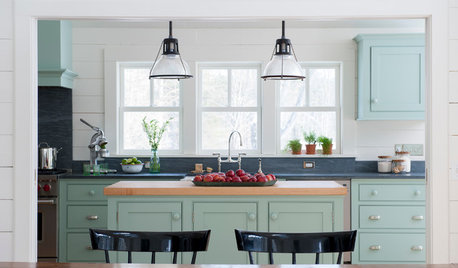

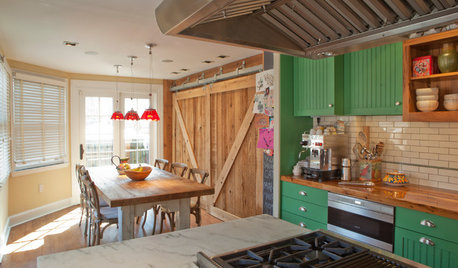
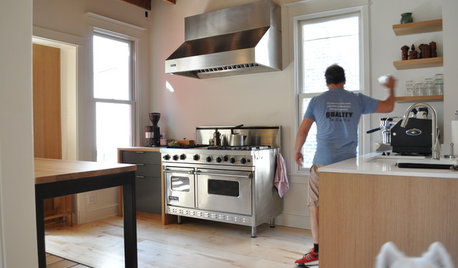
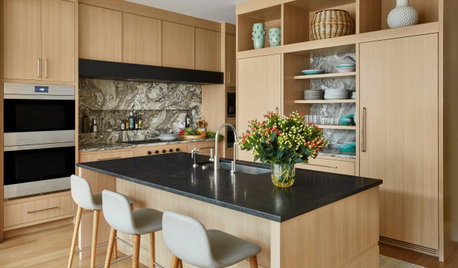











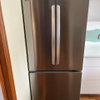
orangedaisy52